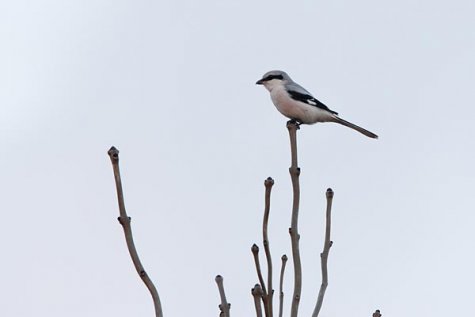Grey shrike watching for prey
Photo: Arne Ader
Translation: Liis
Great grey shrike
Great grey shrike Hallõgija Lanius excubitor
The long-lasting autumn days have turned into pre-winter but bird life proceeds along its own paths.
In a tree top at the verge of the field thegreat grey shrike, thrush-sized and with plumage coloured as the autumn day, keeps watch; about a quarter of a metre long but weighs only 60 to 80 grams. If you move closer the bird flies, with its billowing flight, to a power line or a garden fence, keeping a suitable safe distance to the watcher.
Great grey shrikes nest in bogs without human presence, in Estonia as well as in the North, and the migration still continues. In winter up to a thousand birds may remain here together with the roaming birds from the North. With its ashen grey back plumage and the white underparts, the great grey shrike is not particularly eye-catching – useful for a bird of prey. The tail is long, with white outer feathers at the sides. The crown of the head is the same colour as the body, and the only thing that is visible from far off is the black “robber’s mask“. The beak tip of this small bird of prey is hooked and it hunts in open landscapes, often using hovering flight. The prey consists of small rodents and passerines; it is carried in the claws. Another Estonian name is tihasekull, “tit hawk”.
Should you happen to see prey hung up on branches or between branches, it may be the food store of a great grey shrike.
See Remo Savisaar’s pictorial accusation: LINK
Great grey shrike observations: LINK









